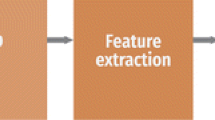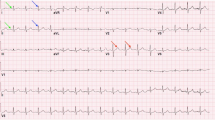Abstract
In this paper, a sparse-technique-based representation of the signal over a learned dictionary and random decrement technique are explored to extract the oscillatory mode from the ambient data. The main contribution of the present work is to design a dictionary and compute the coefficients that best represent the clean signal to estimate the modes. In this work, the noise embedded in the ambient signal is minimized by representing the ambient signal in sparse domain with respect to the dictionary. Comparison between the proposed method and other methods such as nonlinear filtering, etc., has been done on the test signal, two-area power system on the data generated through simulation in Matlab, two-area data simulated on real-time digital simulator and real measurement from Phasor data concentrator (PDC) of Indian power system and Western Electricity Coordinating Council (WECC) network.






Similar content being viewed by others
References
Phadke A G and Thorp J S 2008 Synchronized phasor measurements and their applications. New York, Springer
Sharma R B and Dhole G M 2016 Synchrophasor measurement network and its applications in Indian grid. In: Proceedings of the International Conference on Emerging Trends in Electrical Electronics Sustainable Energy Systems (ICETEESES 2016), Sultanpur, India, pp. 30–34
Korba P, Larsson M and Rehtanz C 2003 Detection of oscillations in power systems using Kalman filtering techniques. In: Proceedings of the IEEE Control Applications, Istanbul, Turkey, pp. 183–188
Hauer J F, Demeure C J and Scharf L L 1990 Initial results in Prony analysis of power system response signals. IEEE Trans. Power Syst. 5: 80–89
Tripathy P, Srivastava S C and Singh S N 2009 An improved Prony method for identifying low frequency oscillations using synchro-phasor measurements. In: Proceedings of the IEEE International Conference on Power Systems (ICPS 2009), Kharagpur, India, pp. 1–5
Rai S, Lalani D, Nayak S K, Jacob T and Tripathy P 2016 Estimation of low-frequency modes in power system using robust modified Prony. IET Gener. Transm. Distrib. 10: 1401–1409
Tripathy P, Srivastava S C and Singh S N 2011 A modified TLS-ESPRIT-based method for low-frequency mode identification in power systems utilizing synchrophasor measurements. IEEE Trans. Power Syst. 26: 719-727
Wies R W, Pierre J W and Trudnowski D J 2003 Use of ARMA block processing for estimating stationary low-frequency electromechanical modes of power systems. IEEE Trans. Power Syst. 18: 167–173
Larsson M and Laila D S 2009 Monitoring of inter-area oscillations under ambient conditions using subspace identification. In: Proceedings of the IEEE PES General Meeting, Calgary, Canada, pp. 1–6
Ning J, Pan X and Venkatasubramanian V 2013 Oscillation modal analysis from ambient synchrophasor data using distributed frequency domain optimization. IEEE Trans. Power Syst. 28: 1960–1968
Zhang P, Wang X, Wang X and Thorp J S 2014 Synchronized measurement based estimation of inter-area electromechanical modes using the Ibrahim time domain method. Electr. Power Syst. Res. 111: 85–95
Thambirajah J, Thornhill N F and Pal B C 2011 A multivariate approach towards inter-area oscillation damping estimation under ambient conditions via independent component analysis and random decrement. IEEE Trans. Power Syst. 26: 315–322
Turunen J, Rauhala T and Haarla L 2010 Selecting wavelets for damping estimation of ambient-excited electromechanical oscillations. In: Proceedings of the IEEE PES General Meeting, Providence, USA, pp. 1–8
Zhang P, Teng Y, Wang X and Wang X 2015 Estimation of inter-area electromechanical modes during ambient operation of the power systems using the RDT–ITD method. Int. J. Electr. Power Energy Syst. 71: 285–296
Turunen J, Thambirajah J, Larsson M , Pal B C, Thornhill N F, Haarla L C, Hung W W, Carter A M and Rauhala T 2011 Comparison of three electromechanical oscillation damping estimation methods. IEEE Trans. Power Syst. 26: 2398–2407
Seppanen J M, Turunen J, Koivisto M, Kishor N and Haarla L C 2014 Modal analysis of power systems through natural excitation technique. IEEE Trans. Power Syst. 29: 1642–1652
James G H, Carne T G and Lauffer J P 1993 The natural excitation technique for modal parameter extraction from operating wind turbines. SAND 92-1666 UC-261, Sandia National Laboratories
Juang J N and Pappa R S 1985 An eigensystem realization algorithm for modal parameter identification and model reduction. J. Guid. Control Dyn. 8: 620–627
Rai S, Tripathy P and Nayak S K 2015 A nonlinear filtering technique along with RD and TLS-ESPRIT for mode identification of ambient data. In: Proceedings of the Annual IEEE India Conference (INDICON 2015), New Delhi, India, pp. 1–6
Rai S, Tripathy P and Nayak S K 2016 An efficient wavelet based technique for oscillatory mode identification of ambient data via RD and TLS-ESPRIT. In: Proceedings of the National Power Systems Conference (NPSC 2016), Bhubaneswar, India, pp. 1–6
Aharon M, Elad M and Bruckstein A 2006 K-SVD: an algorithm for designing overcomplete dictionaries for sparse representation. IEEE Trans. Signal Process. 54: 4311–4322
Rubinstein R, Bruckstein A M and Elad M 2010 Dictionaries for Sparse Representation modeling. Proc. IEEE 98: 1045–1057
Kundur P 1994 Power system stability and control. New York, McGrawHill
WECC 2005 Report and data of WECC. Available online at ftp://ftp.bpa.gov/pub/WAMSInformation/
PDCI 2005 PDCI probe testing plan. Available online at http://www.transmission.bpa.gov/business/operations/SystemNews/
Xiao J, Xie X, Han Y and Wu J 2004 Dynamic tracking of low-frequency oscillations with improved Prony method in wide-area measurement system. In: Proceedings of the IEEE PES General Meeting, Denver, USA, pp. 1104–1109
Tropp J A and Gilbert A C 2007 Signal recovery from random measurements via orthogonal matching pursuit. IEEE Trans. Inf. Theory 53: 4655–4666
Wang J, Kwon S and Shim B 2012 Generalized orthogonal matching pursuit. IEEE Trans. Signal Process. 60: 6202–6216
Rubinstein R, Zibulevsky M and Elad M 2008 Efficient implementation of the K-SVD algorithm and the Batch-OMP method. Technical Report, CS, Technion, Israel
Brincker R, Kren S, Kirkegaard P H and Rytter A 1992 Identification of dynamic properties from correlation function estimates. Bygningsstatiske Meddelelser 63: 1–38
IEEE Std C37.118.1aTM 2014 IEEE Standard for synchrophasor measurements for power systems
Author information
Authors and Affiliations
Corresponding author
Rights and permissions
About this article
Cite this article
RAI, S., TRIPATHY, P. & NAYAK, S.K. Using sparsity to estimate oscillatory mode from ambient data. Sādhanā 44, 90 (2019). https://doi.org/10.1007/s12046-019-1071-7
Received:
Revised:
Accepted:
Published:
DOI: https://doi.org/10.1007/s12046-019-1071-7




